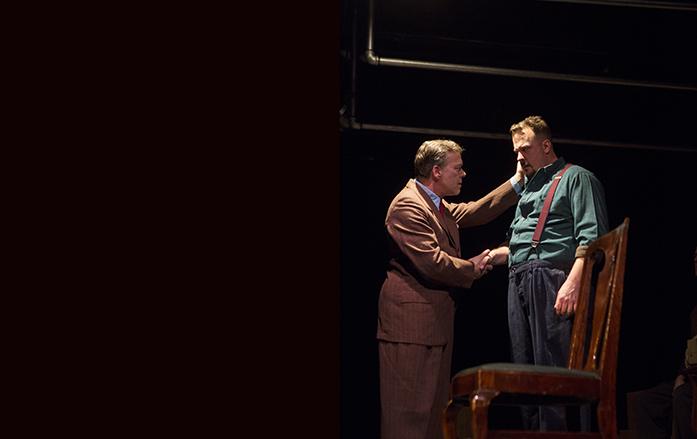By Isaac Hamlet
At first glance, the box-filled stage signifies little more than it appears to be, but over the course of the evening, the boxes will break from their status as bearers of a blank slate to transform the space into the inside of an apartment, a street corner, a corporate office, and a telephone booth.
“I wanted to do [A View from the Bridge] in a new way,” said Sean Christopher Lewis, the artistic director of the Riverside Theater and the director of the play, the company’s first of the year. “We’re using the boxes and everything around us to build the set from scene to scene. It forced us to focus on the moment and the language of the play.”
At 7:30 p.m. Friday, Riverside Theater, 213 N. Gilbert St., will open its production of Arthur Miller’s A View from the Bridge. The play follows Eddie Carbone, a man living in 1957 Brooklyn who decides to take in a family of Italian illegal immigrants while they work in the country.
“He’s a family man and a standup guy,” said Patrick Du Laney, the actor portraying Eddie. “Being a standup person is important to him, which is why he’s willing to bring in these immigrants.”
That a play about immigration will open on Friday — Inauguration Day — is no accident. Although Lewis scheduled the season in July 2016, long before Election Day, he figured immigration would still be at the heart of the political discourse regardless of which candidate won.
That the president-elect has a particularly hard-line stance on immigration is, to Lewis, simply happenstance.
Much like we as a nation might be conflicted about certain arguments made following the election, the play’s characters find themselves somewhat doubtful about their past decisions as they get to know the people they’ve welcomed into their home.
“The people in the play want to help the immigrants at the beginning because they look at them like puppies,” Lewis said. “[Later], they realize that the immigrants are people, too; they realize, ‘They’re not lower than me,’ and that scares them.”
For Eddie, the breakthrough comes when he begins to realize that one of the immigrants he let into his home, Rodolpho, is romancing his niece, Catherine.
“The most challenging part is probably [Catherine’s] relationship with the uncle,” said Katherine Slaven, who plays Catherine. “He’s like a father but also the [romantic interest] in her life — it’s almost incestuous.”
As Slaven describes it, Catherine starts the play so devoted to her uncle that she’s more like a daughter. Her eventual desire to marry Rodolpho and Eddie’s opposition to it forms the play’s central conflict.
“One of the things I like about [the play] is that it’s complicated,” Slaven said. “They’re all human, they’re all flawed — there’s no good guy, there’s no bad guy — you can see where people are coming from.”
This focus on the characters and their motivation was part of Lewis’ plan in implementing a minimalist set. Miller’s ability to “portray the difficulties and hypocrisies of good people” is one of the playwright’s strongest aspects, Lewis said.
Not only that, he believes that his approach makes the play more approachable for those who don’t normally attend the theater.
“I didn’t grow up in theater — I discovered it in college, and I think if I’d seen a play like this before I became a theater person, I would have been bored,” Lewis said. “How can I make this experience become immediately relevant and visceral?”
This drive also helps to shape the overall look of the productions Lewis stages at Riverside.
As much as the staging might seem unusual to the audience, it’s also been an adjustment for the actors. Not only are they required to interact with the same set in different ways, but — because of how the environment is developed — they never really step off stage. Rather, they bring the play’s action all the way to the edge, to a point where they’re almost mingling with the audience.
“It can get easy to hide behind things both figuratively and literally,” Du Laney said. “[The stage] makes things harder and easier at the same time. Harder because we have to think ‘Where are we?’ and stay engaged even off-stage. But we’ve also had what we’re going to be using all through rehearsal.”
Part of this for him was ensuring that he articulated his character correctly. Often in a production, the set will give actors opportunities to communicate their emotions to the audience. With this stripped-down set, however, he focused on honing his actions to have as clear a meaning behind them as possible.
“Your job as an actor is to give the characters reasons,” Du Laney said. “Everyone in the play makes hard choices; even if the audience turns on them, they’re all still human.”
This fundamental humanity in the characters, regardless of what they do or say, is something that the cast members want the audience to walk away with: that even the most dark, cruel actions come from a human place.
“I hope that after the show, people are having conversations about how they feel about the characters in the play,” Slaven said. “Hopefully, even if they don’t agree with what a character does, they can understand them.”
Through all of this, Lewis intends for the audience to walk away feeling empathy with the play’s central characters and themes. He hopes this can be achieved by effectively translating the 60-year-old text into contemporary language.
“I don’t know why you see theater if it’s not an experience,” he said. “We’re an art organization; we should make art. Let’s make something completely singular for the experience.”



